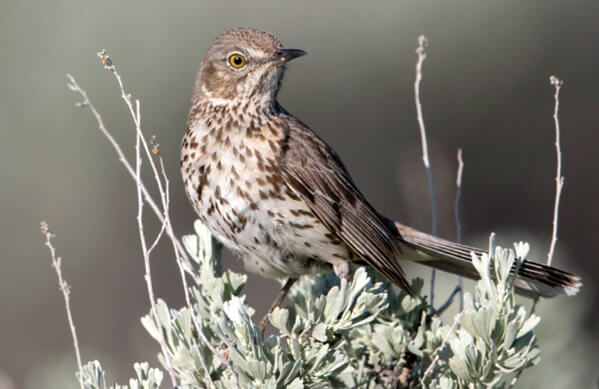 The plain-looking, yellow-eyed Sage Thrasher is sometimes called the “mountain mockingbird” due to its song — a long, melodious jumble of musical notes and phrases reminiscent of the widespread Northern Mockingbird.
The plain-looking, yellow-eyed Sage Thrasher is sometimes called the “mountain mockingbird” due to its song — a long, melodious jumble of musical notes and phrases reminiscent of the widespread Northern Mockingbird.
This lively song inspired American ornithologist A.C. Bent to dub the Sage Thrasher “the poet of the lonesome sagebrush plain.”
True to its scientific name, Oreoscoptes montanus (“mimic of the mountains”), the Sage Thrasher imitates other birds that share its habitat, including Western Meadowlark, Brewer's Sparrow, and Horned Lark. In fact, genetic studies by ornithologists Charles Sibley and Jon Ahlquist show that this smallest North American thrasher species may be more closely related to the mockingbird family than to other thrashers.
Sagebrush Specialist
The Sage Thrasher breeds in dry, open sagebrush steppes across the western United States. It's a short-distance migrant, moving only as far south as Mexico for the winter.
Like other birds dependent upon sagebrush habitats, including Greater Sage-Grouse and Sagebrush Sparrow, Sage Thrasher populations have declined as the wide-open spaces of the American West have been put to increasing human use. Along with direct clearing of habitat for development, invasive plants such as cheatgrass — a weed imported from Eurasia in the 1800s – have made vast areas of former sage habitat unusable for sage-obligate species like these.
During migration and winter, Sage Thrashers can be found in a wider range of habitats, including grasslands with scattered shrubs and open pinyon-juniper woodlands. Our work with Pronatura Noreste in northern Mexico helps to protect wintering habitat for the thrasher, as well as birds like Baird's Sparrow and Worthen's Sparrow, a species found only in Mexico's Chihuahuan Desert.

Sage Thrasher by Michael J. Parr
Long-legged Bug Chaser
Similar to other thrashers, the Sage Thrasher forages on the ground, chasing down a variety of insects, including ants, wasps, and beetles, on long, strong legs. It may also take berries, particularly during migration and on the wintering grounds.
Sign up for ABC's eNews to learn how you can help protect birds
When courting, the male flies in a series of undulating circles over his territory while singing, then lands on top of a sagebrush or other perch with wings held high, a behavior known as a "bilateral wing display."
Sage Thrashers nest on or near the ground in tall, dense sagebrush with overhead cover. This site choice may be a strategy to deter aerial predators such as hawks. Nests are often oriented eastward to capture the sun's heat on cool desert mornings and shade the eggs during baking-hot afternoons.
Sage Thrashers recognize Brown-headed Cowbird eggs and quickly eject them from their nests, so are rarely affected by cowbird parasitism.
Saving Sagebrush Thrasher and Other Species
Although the Sage Thrasher is still considered fairly common, this species has shown troubling declines. Data compiled by the North American Breeding Bird Survey between 1966 and 2014 show a cumulative decline of 52 percent in the overall population.
ABC's work to conserve Greater Sage-Grouse — including advocating for effective management plans for the species on public lands — also benefits the Sagebrush Thrasher. Unfortunately, the U.S. Department of the Interior recently announced a proposal to substantially alter existing conservation plans for Greater Sage-Grouse across 10 states.
These hard-won plans were developed by stakeholders across the West, and many oppose weakening them. Add your voice by speaking out during Interior's comment period and by sending letters to decision-makers via our action alert system!
Donate to help protect Sage Thrasher and other birds!



















































